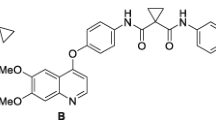Abstract
In the present study substituted 1,2-naphthoquinones were synthesized, purified and characterized by spectroscopic studies (UV, FT-IR, 1H NMR, 13 C NMR and elemental analysis). These compounds were evaluated for cytotoxicity against a panel of human cancer cell lines (Hep-G2 for liver sarcoma, MG-63 for osteosarcoma and MCF-7 for human breast cancer). The cells were dosed with these ortho-naphthoquinone derivatives at varying concentrations, and cell viability was measured by a 3-(4,5-dimethylthiazol-2-yl)-2, 5-diphenyltetrazolium bromide (MTT) assay with doxorubicin as positive control. Significant anticancer activities were observed in vitro for some members of the series, and compounds 1,2-naphthoquinone 2-thiosemicarbazone (3), 1,2-naphthoquinone-2-semicarbazone (4), 4-amino-1,2-naphthoquinone 2-thiosemicarbazone (7) and 4-amino-1,2-naphthoquinone-2-semicarbazone (8) are active cytotoxic agents against different cancer cell lines with IC50 values in the range of 5.73–17.67 μM. The obtained data suggested that better anticancer activity was linked with introduction of thiosemicarbazone and semicarbazone moiety in 1,2-naphthoquinone ring system. Outcomes of experimentation also reveal that incorporation of amino group in 1,2-naphthoquinone moiety contributes positively for cytotoxic action of compounds. Docking experiments showed a good correlation between their calculated interaction energies with the topoisomerase-II and the observed IC50 values of all these compounds.











Similar content being viewed by others
References
Driscoll, J. S., Hazard, G. F., Wood, H. B., & Goldin, A. (1974). Cancer Chemotherapy Reports. Part 2, 4, 1–362.
Liu, K. C., Li, J., & Sakya, S. (2004). Mini Reviews in Medicinal Chemistry, 4, 1105–1125.
Thirumurugan, R. S., Kavimani, S., & Srivastava, R. S. (2000). Biological and Pharmaceutical Bulletin, 23(12), 1438–1440.
Siripong, P., Kanokmedakul, K., Piyaviriyakul, S., Yahuafai, J., Chanpai, R., Ruchirawat, S., & Oku, N. (2006). J. Trad. Med., 23(5), 166–172.
Siripong, P., Hahnvajanawong, C., Yahuafai, J., Piyaviriyakul, S., Kanokmedhakul, K., Kongkathip, N., Ruchirawat, S., & Oku, N. (2009). Biological and Pharmaceutical Bulletin, 32(7), 1251–1260.
Kongkathip, N., Kongkathip, B., Siripong, P., Sangma, C., Luangkamin, S., Niyomdecha, M., Pattanapa, S., Piyaviriyakul, S., & Kongsaeree, P. (2003). Bioorganic & Medicinal Chemistry, 11, 3179–3191.
Dubin, M., Fernandez Villamil, S. H., & Stoppani, A. O. (2001). Medicina (Buenos Aires), 61(3), 343–350.
Frydman, B., Marton, L. J., Sun, J. S., Neder, K., Witiak, D. T., Liu, A. A., Wang, H. M., Mao, Y., Wu, H. Y., Sanders, M. M., & Liu, L. F. (1997). Cancer Research, 57, 620–627.
Lai, C. C., Liu, T. J., Ho, L. K., Don, M. J., & Chau, Y. P. (1998). Histology and Histopathology, 13, 89–97.
Pardee, A. B., Li, Y. Z., & Li, C. J. (2002). Current Cancer Drug Targets, 2, 227–242.
Pink, J. J., Wuerzberger-Davis, S., Tagliarino, C., Planchon, S. M., Yang, X., Froelich, C. J., & Boothman, D. A. (2000). Experimental Cell Research, 255, 144–155.
Planchon, S. M., Pink, J. J., Tagliarino, C., Bornmann, W. G., Varnes, M. E., & Boothman, D. A. (2001). Experimental Cell Research, 267, 95–106.
Vanni, A., Fiore, M., De Salvia, R., Cundari, E., Ricordy, R., Ceccarelli, R., & Degrassi, F. (1998). Mutation Research, 401, 55–63.
Wang, D., Ming, Y. X., Zheng, C., Shinichi, T., Satoshi, O., & Takashi, I. (2004). Biological and Pharmaceutical Bulletin, 27(7), 1025–1030.
Saha, D. K., Padhye, S., Sinn, E., & Newton, C. (2002). Indian J. Chem., Sect. A: Inorg., Bio-inorg., Phys., Theor. Anal. Chem., 41A, 279–283.
Afrasiabi, Z., Sinn, E., Kulkarni, P. P., Ambike, V., Padhye, S., Deobagakar, D., Heron, M., Gabbutt, C., Anson, C. E., & Powell, A. K. (2005). Inorganica Chimica Acta, 358, 2023–2030.
Hu, W. X., Zhou, W., Xia, C. N., & Wen, X. (2006). Bioorganic & Medicinal Chemistry Letters, 16, 2213–2218.
Dutta, S., Padhye, S., Priyadarsini, K. I., & Newton, C. (2005). Bioorganic & Medicinal Chemistry Letters, 15, 2738–2744.
Ishikawa, T., Saito, T., Kurosawa, A., Watanabe, T., Maruyama, S., Ichikawa, Y., Yamada, R., Okuzawa, H., Sato, H., & Ueno, K. (2011). Chemical and Pharmaceutical Bulletin, 59(4), 472–475.
Terzioğlu, N., & Gürsoy, A. (2003). European Journal of Medicinal Chemistry, 38, 781–786.
Li, C. J., Wang, C., & Pardee, A. B. (1955). Cancer Research, 55, 3712.
Planchon, S. M., Wuerzberger, S., & Frydman, B. (1995). Cancer Research, 55, 3706.
Li, C. J., Averboukh, I., & Pardee, A. B. (1993). Journal of Biological Chemistry, 268, 22463.
Boothman, D. A., Trask, D. K., & Pardee, A. B. (1989). Cancer Research, 49, 605.
Frydman, B., Marton, L. J., & Sun, J. S. (1997). Cancer Research, 57, 620.
Wilstermann, A. M., & Osheroff, N. (2003). Current Topics in Medicinal Chemistry, 3, 321–338.
McClendon, A. K., & Osheroff, N. (2007). Mutation Research, 623, 83–97.
Holm, C., Goto, T., Wang, J. C., & Botstein, D. (1985). Cell, 41, 553–563.
Heck, M. M., & Earnshaw, W. C. (1986). The Journal of Cell Biology, 103, 2569–2581.
Heck, M. M., Hittelman, W. N., & Earnshaw, W. C. (1988). Proceedings of the National Academy of Sciences of the United States of America, 85, 1086–1090.
Furniss, B.S., Hannaford, A.J., Smith P.W.G. (1995) Vogel’s Textbook of practical organic chemistry, 5th ed. Longman Science and Technology, Longman Group UK Limited, Harlow pp. 1026–1027.
Reddy, D. M., Srinivas, J., Chashoo, G., Saxena, A. K., & Sampath Kumar, H. M. (2011). European Journal of Medicinal Chemistry, 46, 1983–1991.
Jorgensen, W. L., Maxwell, D. S., & Tirado-Rives, J. (1996). Journal of the American Chemical Society, 118, 11225–11236.
Fieser, L. F., & Hartwell, J. L. (1935). Journal of the American Chemical Society, 57, 1482.
Sengupta, D., Verma, D., & Naik, P. K. (2007). Journal of Biosciences, 32, 1307–1316.
Moorthy, N. S. H. N., Karthikeyan, C., & Trivedi, P. (2009). Medicinal Chemistry, 5, 549–557.
Acknowledgements
The authors are grateful to the head of the Department of Chemistry, Faculty of Science, Banaras Hindu University (BHU), and Varanasi, India, for 1H NMR and 13 C NMR spectroscopy. One of the authors, Shubhanjali Shukla, thanks the Jawahar Lal Nehru Memorial Fund, New Delhi, for providing financial assistance to continue the research.
Author information
Authors and Affiliations
Corresponding author
Rights and permissions
About this article
Cite this article
Shukla, S., Srivastava, R.S., Shrivastava, S.K. et al. Synthesis, Characterization and Antiproliferative Activity of 1,2-Naphthoquinone and Its Derivatives. Appl Biochem Biotechnol 167, 1430–1445 (2012). https://doi.org/10.1007/s12010-012-9551-9
Received:
Accepted:
Published:
Issue Date:
DOI: https://doi.org/10.1007/s12010-012-9551-9




